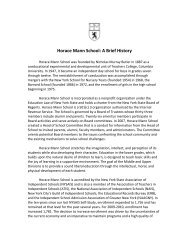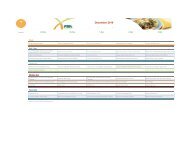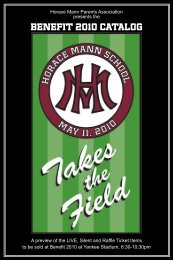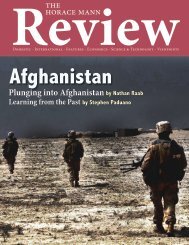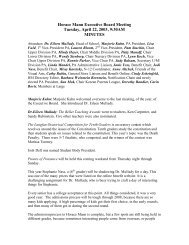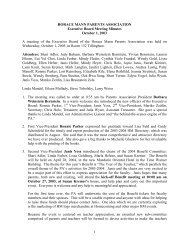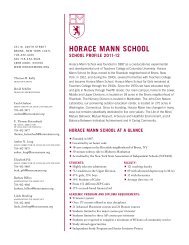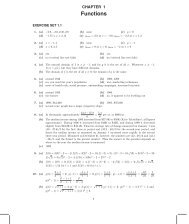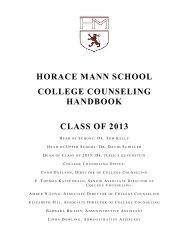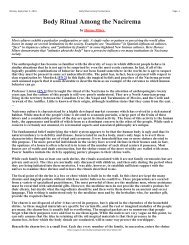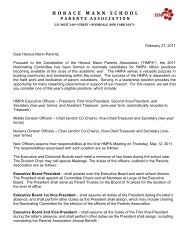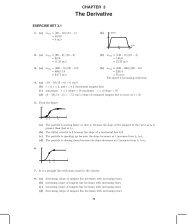description and history - Horace Mann School
description and history - Horace Mann School
description and history - Horace Mann School
You also want an ePaper? Increase the reach of your titles
YUMPU automatically turns print PDFs into web optimized ePapers that Google loves.
○ ○ ○ ○ ○ ○ ○ ○ ○ ○ ○<br />
○ ○ ○<br />
○ ○ ○ ○ ○ ○ ○ ○ ○ ○ ○ ○ ○ ○ ○ ○ ○ ○ ○ ○ ○ ○ ○ ○ ○ ○ ○ ○ ○ ○ ○ ○ ○ ○ ○ ○ ○ ○ ○ ○ ○ ○ ○ ○ ○ ○ ○ ○ ○ ○ ○ ○ ○ ○ ○ ○ ○ ○ ○ ○ ○ ○ ○ ○ ○ ○ ○<br />
○ ○ ○ ○ ○ ○ ○ ○ ○ ○ ○ ○ ○ ○ ○ ○ ○ ○ ○ ○ ○ ○ ○ ○ ○ ○ ○ ○ ○ ○ ○ ○ ○ ○ ○ ○ ○ ○ ○ ○ ○ ○ ○ ○ ○ ○ ○<br />
S<br />
○ ○ ○ ○ ○ ○ ○ ○ ○ ○<br />
into two distinct groups. The first group includes presentation<br />
tools created by the teacher. The main concern<br />
of the teachers here was the time needed to<br />
create the projects. Several teachers indicated that<br />
the time spent creating these electronic presentations<br />
was productive only if they were able to use<br />
the presentation more than once.<br />
The second type of presentation tool consisted<br />
of multimedia professionally produced on CD-ROMs<br />
<strong>and</strong> laser discs. While most of these applications were<br />
well received by teachers <strong>and</strong> students, there were<br />
some concerns raised about their inflexibility. Specifically,<br />
the biology teacher who used the pig dissection<br />
program found that she was bound by the<br />
pedagogy of the program <strong>and</strong> was unable to modify<br />
the application to meet her own style of teaching.<br />
Another complaint about professionally produced<br />
multimedia came from <strong>history</strong> teachers who found<br />
that there were very few products available for topics<br />
other than American <strong>history</strong> <strong>and</strong> twentieth century<br />
<strong>history</strong>.<br />
Representation/Construction<br />
Of all the categories, this one was perhaps the best<br />
received by students <strong>and</strong> teachers. Students found<br />
that working with models <strong>and</strong> simulations was an<br />
exciting <strong>and</strong> different approach to learning. Teachers<br />
found that the high degree of interest on the part<br />
of students was an asset to instruction. One math<br />
teacher also noted that the Sketchpad program enabled<br />
many of her weaker students to have success<br />
with difficult concepts. Another math teacher noted<br />
that simulations often enabled students to look at<br />
more advanced concepts because they were less<br />
inhibited by the constraints of calculation.<br />
Representation projects vary greatly in terms of<br />
the amount of freedom the students have in exploring<br />
or playing with the information in each application.<br />
Simulations like the Decisions Decisions game,<br />
while allowing some student choice, had a relatively<br />
closed set of outcomes. Simulations <strong>and</strong> models with<br />
closed outcomes may be very interesting to students<br />
at first, but could not be reused. Therefore an application<br />
like Decisions Decisions may only be useful<br />
for one or two lessons. On the other h<strong>and</strong>, a math<br />
tool such as Sketchpad is much more open in the<br />
way it allows students to use it. Applications with<br />
open outcomes were more likely to be used repeatedly<br />
<strong>and</strong> for a variety of lessons without a decline in<br />
the level of student interest. The downside of applications<br />
with open ended outcomes is that using<br />
them well usually requires more preparation time by<br />
the teacher.<br />
Composition<br />
Despite the fact that this category had the largest<br />
number of projects, it also received the largest number<br />
of complaints from teachers <strong>and</strong> students. In<br />
short composing on the computer is time consuming<br />
<strong>and</strong> difficult. While there have been several very<br />
successful projects done by individual students using<br />
software such as HyperCard, many of the teachers<br />
surveyed felt that it took too much time to develop<br />
<strong>and</strong> implement a project. Likewise the students<br />
felt that the projects took too much time.<br />
Teachers attribute the time problem to their<br />
own lack of technical training, the current level of<br />
the students’ technical skills, as well as the difficulty<br />
of access to specialized technology such as scanners<br />
<strong>and</strong> Quicktime Video. Several teachers said that they<br />
would be reluctant to try a composition project again<br />
without more training, more planning, <strong>and</strong> better<br />
access to facilities. However teachers that have repeated<br />
composition projects, such as the multimedia<br />
projects done in American History, found that the<br />
projects worked much better the second time<br />
around.<br />
The same concepts of “openness’ <strong>and</strong><br />
“closedness” mentioned in the representation category<br />
was also noticed by art teachers. While they<br />
enjoyed the freedom to copy, duplicate <strong>and</strong> edit that<br />
the computer gave the students, art teachers were<br />
very aware of the limitations of each program. One<br />
teacher said that the format of the application’s tools<br />
influenced the work done by students too much. For<br />
example, the tools in the ClarisWorks Painting Environment<br />
suggested to students only to draw regular<br />
geometric shapes.<br />
Communication<br />
Of all the categories, communication received the<br />
greatest range of results. On one end were some of<br />
the least successful projects <strong>and</strong> at the other some<br />
of the most successful. For all of the projects success<br />
seemed to be determined by the level <strong>and</strong> type<br />
of teacher involvement. The projects that were conducted<br />
during class time such as the Cooperative<br />
Research Project in Science, were very well received.<br />
13



